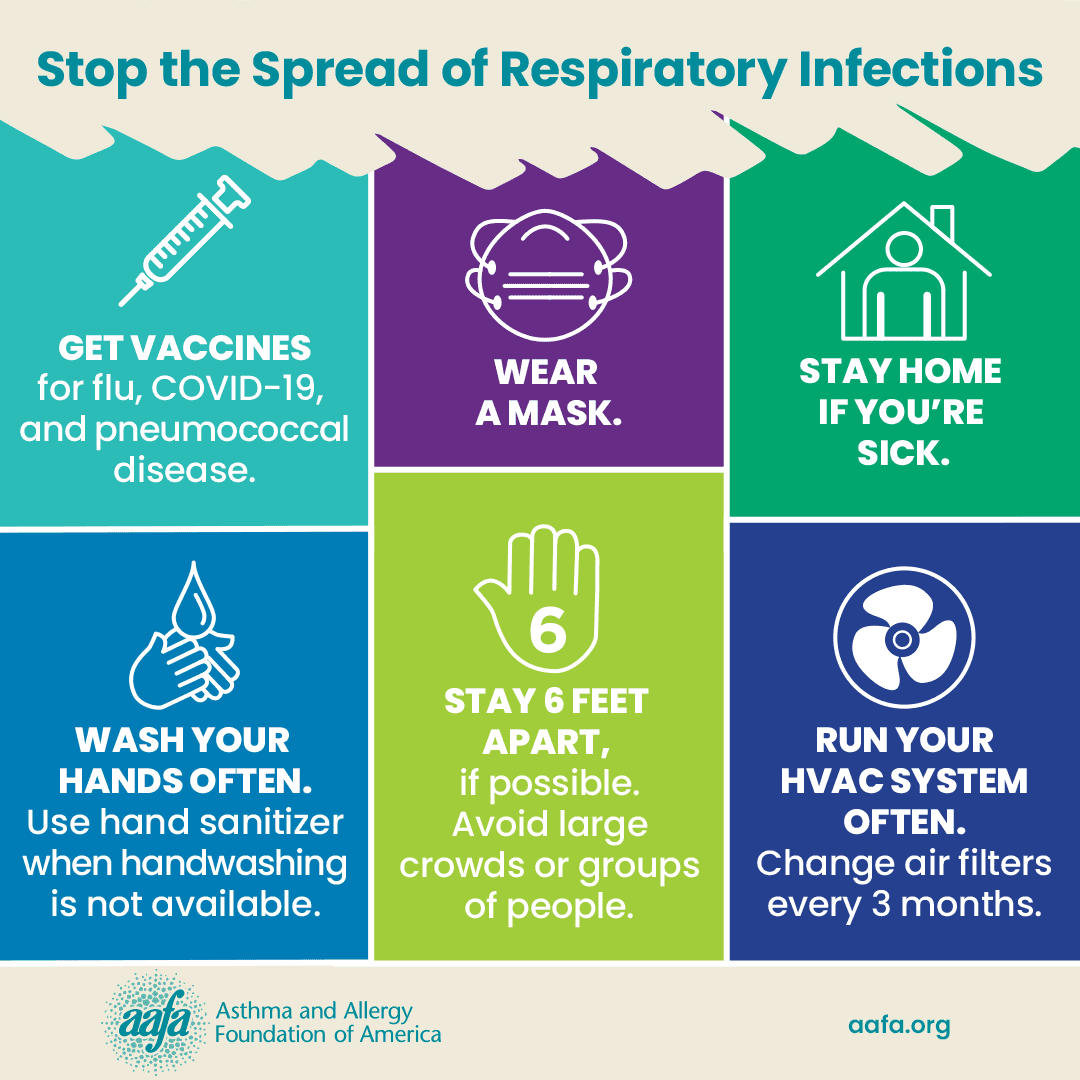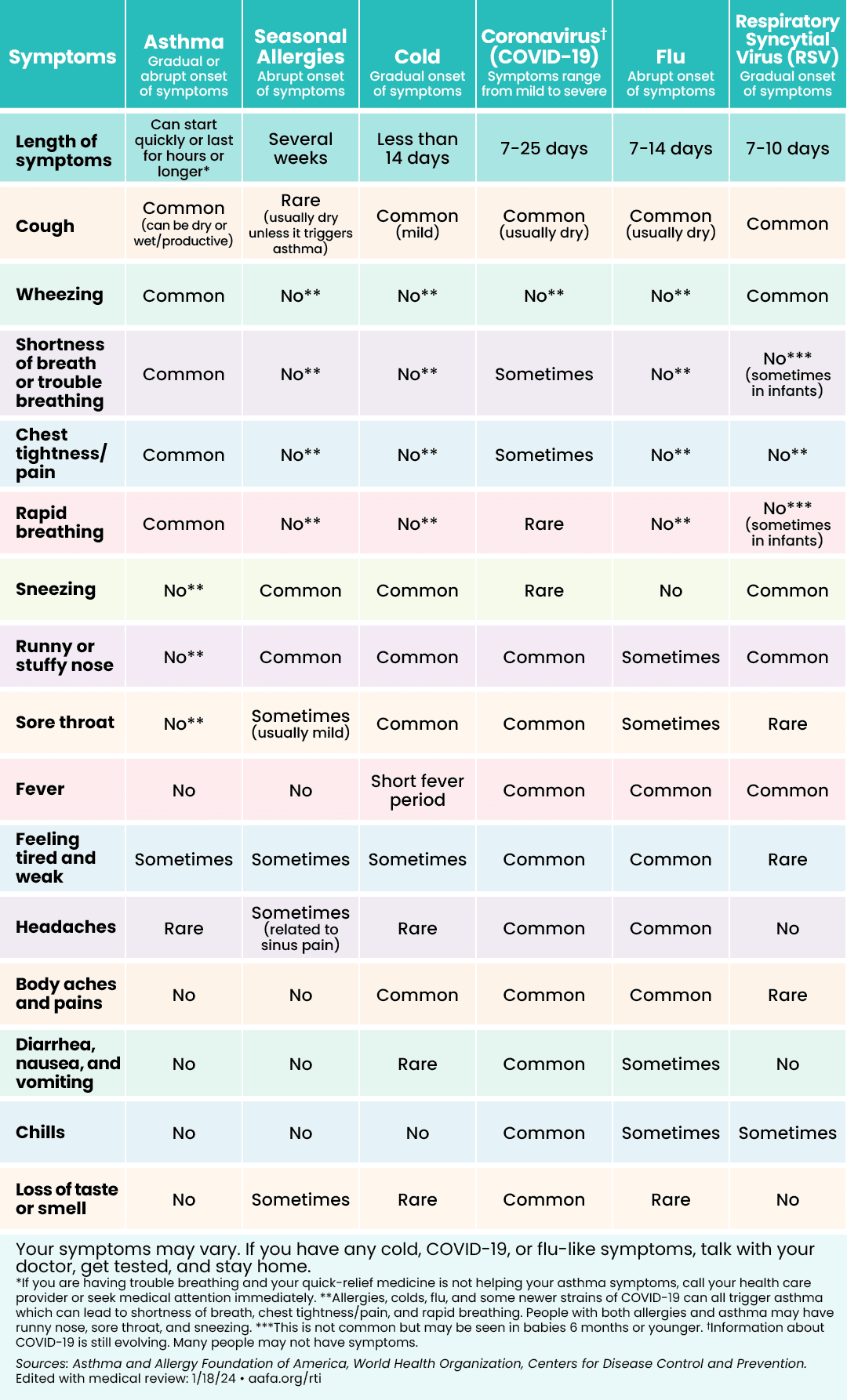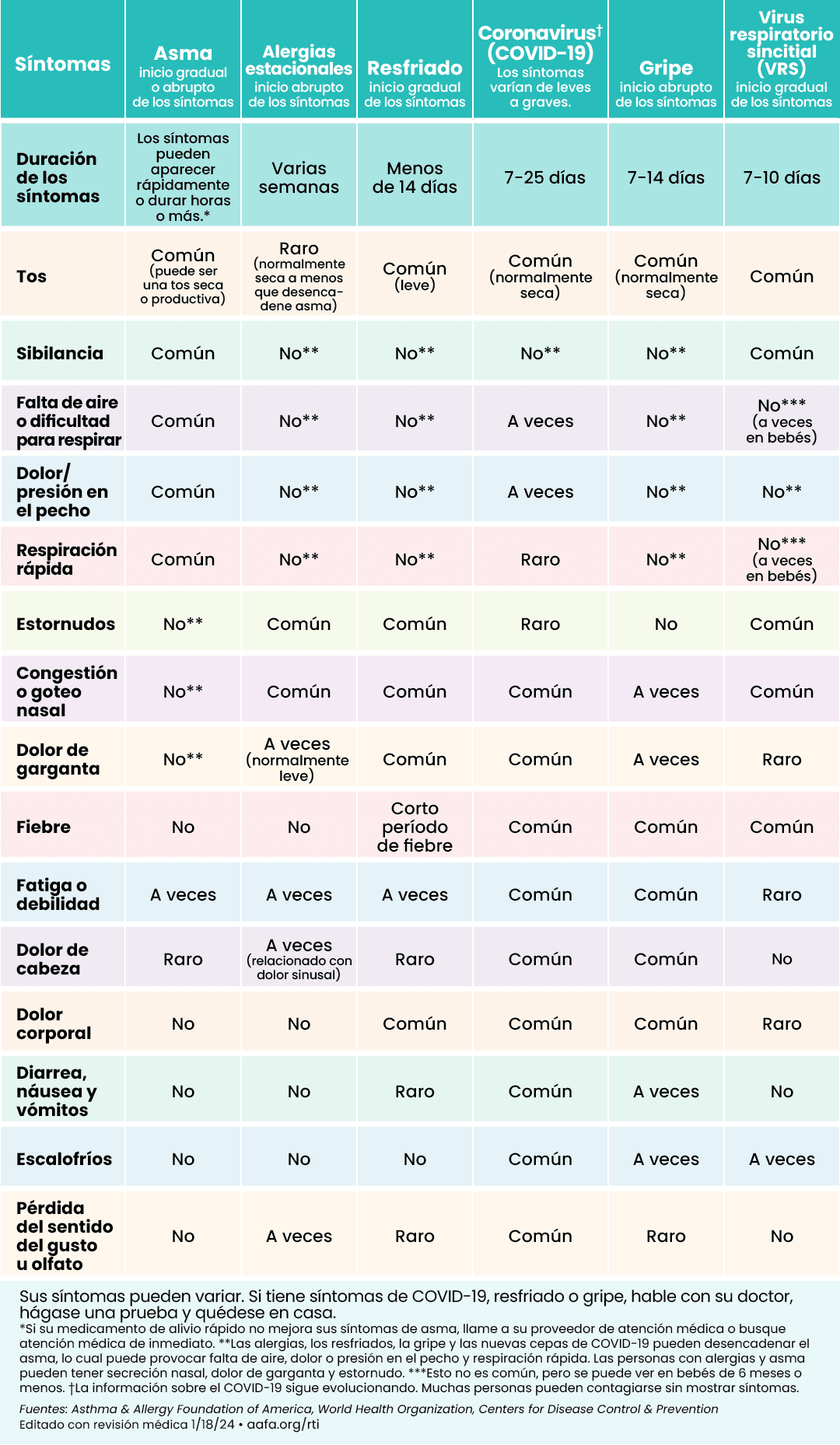With every cough or sniffle, you may wonder if it’s asthma or allergies, the flu, respiratory syncytial [sin-SISH-uhl] virus (RSV), the common cold, or even COVID-19. But how can you tell the difference?
The Asthma and Allergy Foundation of America (AAFA) created a respiratory symptoms chart to help you recognize the similarities and differences between these conditions.
Asthma Symptoms
Asthma is a chronic disease that causes your airways to be inflamed. The best way to manage it is to take your asthma medicines, avoid your triggers, and treat asthma symptoms as soon as they occur.
Common symptoms of asthma include:
- Shortness of breath
- Cough
- Chest tightness or pain
- Wheeze (a whistling sound when you breathe)
- Waking at night due to asthma symptoms
- A drop in your peak flow meter reading (if you use one)
Symptoms can come on gradually, or they can come on suddenly.
What to Do If You Have Asthma Symptoms
At the first sign of asthma symptoms, take your quick-relief (sometimes called “rescue”) medicine. Follow the Yellow/Caution Zone on your Asthma Action Plan. The earlier you treat asthma symptoms, the better your chances are of not having an asthma emergency.
Asthma can be life-threatening, so it’s important to know the signs of an asthma emergency and to keep your quick-relief inhaler with you at all times.
Red/Danger Zone symptoms are a medical emergency. Take your quick-relief medicines right away as directed on your Asthma Action Plan and then get immediate medical attention. Call 911 or go directly to the emergency room if you have these asthma symptoms:
- Asthma is getting worse quickly
- Asthma quick-relief medicines are not helping
- Chest tightness or pain
- Severe shortness of breath
- Breathing is faster or slower than normal
- Breathing may be hard or shallow
- Trouble walking or talking due to shortness of breath
- Chest retractions (skin sucks in between or around the neck, chest plate, and/or rib bones when inhaling; this is rare in adults)
- Ribs or stomach moving in and out deeply and rapidly
- Expanded chest that does not deflate when you exhale
- Shoulders hunched over
- Cyanosis, a tissue color change on mucus membranes (tongue, lips, and around the eyes) and fingertips or nail beds – the color appears grayish or whitish on darker skin tones and bluish on lighter skin tones
COVID-19 Symptoms
COVID-19 is caused by the SARS-CoV-2 virus. According to the Centers for Disease Control and Prevention (CDC), COVID-19 symptoms can include:
- Fever
- Chills
- Cough
- Shortness of breath or trouble breathing
- Feeling tired and weak – more than usual
- Muscle or body aches
- Headache
- New loss of taste or smell
- Sore throat
- Stuffy or runny nose
- Diarrhea
- Nausea or vomiting
This list may not include all of the symptoms. Symptoms may appear 2 to 14 days after coming in contact with the virus. If you have any symptoms that are severe or concerning, call your doctor.
If you have these severe symptoms, call 911 or go to the emergency room right away:
- Trouble breathing or shortness of breath
- Pain or pressure in the chest that doesn’t go away
- New and sudden confusion
- Can’t wake up or stay awake
- Cyanosis which is tissue color changes on mucus membranes (like tongue, lips, and around the eyes) and fingertips or nail beds – the color appears grayish or whitish on darker skin tones and bluish on lighter skin tones
People ages 6 months and older can get a COVID-19 vaccine.
What to Do If You Have COVID-19 Symptoms
If you have any of the symptoms above or if you have been exposed to someone who has COVID-19, get tested. If you test positive, contact your doctor right away. They may want you to take an antiviral medicine and or additional medicines to support your symptoms.
Also wash your hands often, wear a mask, and stay home if you are sick. Pay attention to your symptoms, and if they get worse, call your doctor and get emergency care right away. Get plenty of rest and continue to take your asthma medicines as prescribed by your health care provider.
Flu (Influenza) Symptoms
The flu is a contagious respiratory illness caused by influenza viruses. Symptoms can start suddenly and can cause mild to severe illness. It can also cause death in severe cases. Common flu symptoms include:
- Fever (often very high, 101°F or above)
- Headache
- Extreme tiredness
- Chills
- Constant cough
- Sore throat
- Runny or stuffy nose
- Body aches in bones and/or muscles
- Diarrhea and vomiting (more common in children)
Thankfully, a flu vaccine is available. To reduce your chances of getting and spreading the flu, get the flu vaccine every year. The CDC recommends that people ages 6 months and older get the flu vaccine. Even if you catch a strain of flu that isn’t covered by the current year’s vaccine, getting vaccinated can make your illness less severe and lower your chance of being hospitalized.
People with asthma, as well as senior adults and people with other pre-existing conditions, are at high risk of complications from the flu.
It is important to get the flu vaccine every year. It can reduce your chances of having complications (serious health problems).
What to Do If You Have Flu Symptoms
If you have flu symptoms or are exposed to someone with the flu, contact your doctor right away. There are antiviral treatments for the flu that can lessen symptoms and may shorten the time you are sick. But you have to take them within 1 to 2 days of getting sick.
If you start having flu symptoms and have trouble breathing, follow your Asthma Action Plan and contact your doctor right away.
Respiratory Syncytial Virus (RSV)
RSV is a virus that affects your lungs. It is a common virus with cold-like symptoms that can affect people of all ages. RSV is the most common cause of pneumonia and airway inflammation in children in the United States younger than 1 year of age.
Most people have mild symptoms and recover from RSV within a week or two. But RSV can be serious for certain people who are at high risk, like infants and older adults.
RSV symptoms can take as long as 4 to 6 days to show up after contact with the virus. Symptoms include:
- Runny nose
- Stuffy nose
- Eating less or not interested in eating
- Coughing
- Sneezing
- Red, inflamed eyes (conjunctivitis)
- Fever
- Wheezing (a whistling sound when breathing)
Symptoms in very young infants may be different. They can include:
- Being irritable or cranky (fussiness)
- Eating or drinking less or not interested in eating
- Decreased activity and poor responsiveness
- Trouble breathing (for example, cough, shortness of breath, wheezing, and respiratory distress)
- Faster breathing than usual
- Pauses in breathing that last more than 10 seconds
Call your child’s doctor right away if your child is having trouble breathing, not drinking enough fluids, not responding well, and/or their symptoms are getting worse.
What to Do If You Have RSV Symptoms
If you have asthma, contact your doctor right away if you have symptoms of RSV. Or if your infant has RSV symptoms – whether they have asthma or not – contact their doctor.
Most RSV infections will go away on their own. RSV is caused by a virus, so antibiotics will not help. Talk with your doctor about taking over-the-counter medicines to help with symptoms, like pain relievers or cough and cold medicine. Be sure to talk with your doctor about how to take these medicines appropriately. Ask about nasal suction and lubrication – such as a nasal saline spray, mist, or drops – which may help ease congestion. Drink plenty of fluids and rest. Limit your time around other people to prevent spreading RSV.
Cold Symptoms
The common cold is usually mild compared to the flu and COVID-19. But even a mild cold can trigger asthma symptoms, so if you catch a cold, you want to take it seriously.
Common symptoms of a cold include:
- Mild cough
- Sneezing
- Runny or stuffy nose
- Sore throat
- A short fever
- Aches and pains
What to Do If You Have Cold and Other Respiratory Symptoms
If you start having trouble breathing when sick with a cold, follow your Asthma Action Plan. Contact your doctor if symptoms do not improve. And get medical help right away for emergency asthma symptoms.
Nasal Allergy (Rhinitis) Symptoms
Irritants and allergens can cause inflammation (swelling) in your nose. This is called rhinitis. When you have symptoms during a certain season of the year or when you are exposed to certain allergens, it’s commonly called allergic rhinitis or “hay fever.”
Common allergens that can cause rhinitis include animal dander, dust mites, mold, and pollen.
Allergy symptoms can include:
- Itching in the nose and eyes
- Sneezing
- Stuffy nose (congestion)
- Runny nose
- Mucus (phlegm) in the throat (postnasal drip)
The inflammation (swelling and irritation) in your nose can cause it to produce a fluid called mucus. The mucus may flow out of your nose, as well as down the back of your throat. It can irritate the back of your throat and cause coughing.
Allergies are not contagious, unlike colds, the flu, and COVID-19. They are caused by a reaction of your immune system.
What to Do If You Have Allergy Symptoms
If you have allergies, the best way to prevent or reduce symptoms is to reduce or avoid contact with the things you are allergic to. Some steps you can take include:
For dust mite allergy:
- Use CERTIFIED asthma & allergy friendly® dust mite-proof covers for pillows, comforters, duvets, mattresses, and box springs.
- Wash your bedding and pillowcases in hot water weekly to reduce allergens.
For animal dander allergy:
- Keep pets out of the bedroom to reduce pet dander allergen in your bedding.
For mold allergy:
- Run a fan in your bathroom for 15 to 20 minutes after showering or bathing.
- Fix plumbing leaks in your home as soon as possible.
For pollen allergy:
- Plan indoor activities on days when pollen counts are high.
- Keep your windows closed during high pollen and mold seasons, if possible. When entering your home, leave your shoes at the door.
- Wear sunglasses, a hat, and a face mask to protect pollen from getting in your eyes, nose, and mouth when outdoors on high pollen days.
In general:
- Replace the filters on your heating/air conditioning units as recommended by the manufacturer.
If reducing your exposure to allergens isn’t enough, there are several treatments that can help. Treatments can include nasal sprays, antihistamines, decongestants, and immunotherapy (allergy shots). See a board-certified allergist for allergy testing. They can recommend a treatment plan to help you get relief.
Uncontrolled rhinitis can lead to sinusitis, a sinus infection. If you have asthma, rhinitis symptoms can irritate your lungs and cause asthma symptoms. If you have allergies, it’s important to get treatment to make sure they are well-controlled.
How to Reduce the Spread of COVID-19, the Flu, and Other Respiratory Illnesses
What can you do to reduce your chances of getting sick? To stop the spread of respiratory infections:
- Get vaccinated
- Wash hands often for at least 20 seconds with soap and water
- Wear an N95 face mask when respiratory infections are high in your community
- Increase air flow in your indoor environment

If you have asthma, keeping your asthma under control can reduce your chances of having a severe asthma episode or attack if you get sick.
If you do get sick, get plenty of rest, drink water, and follow your Asthma Action Plan if you have asthma.
Always contact your doctor about any concerning symptoms, no matter what. And go to the emergency department or call 911 for emergency signs and symptoms.
Medical Review: based on the following webpages: COVID-19 (Coronavirus Disease), Asthma, and Allergies reviewed September 2024 by Neeta Ogden, MD; Flu (Influenza) reviewed September 2024 by John James, MD; Respiratory Syncytial Virus (RSV) October 2024 by John James, MD; and Nasal Allergies (Rhinitis)



Comments (0)